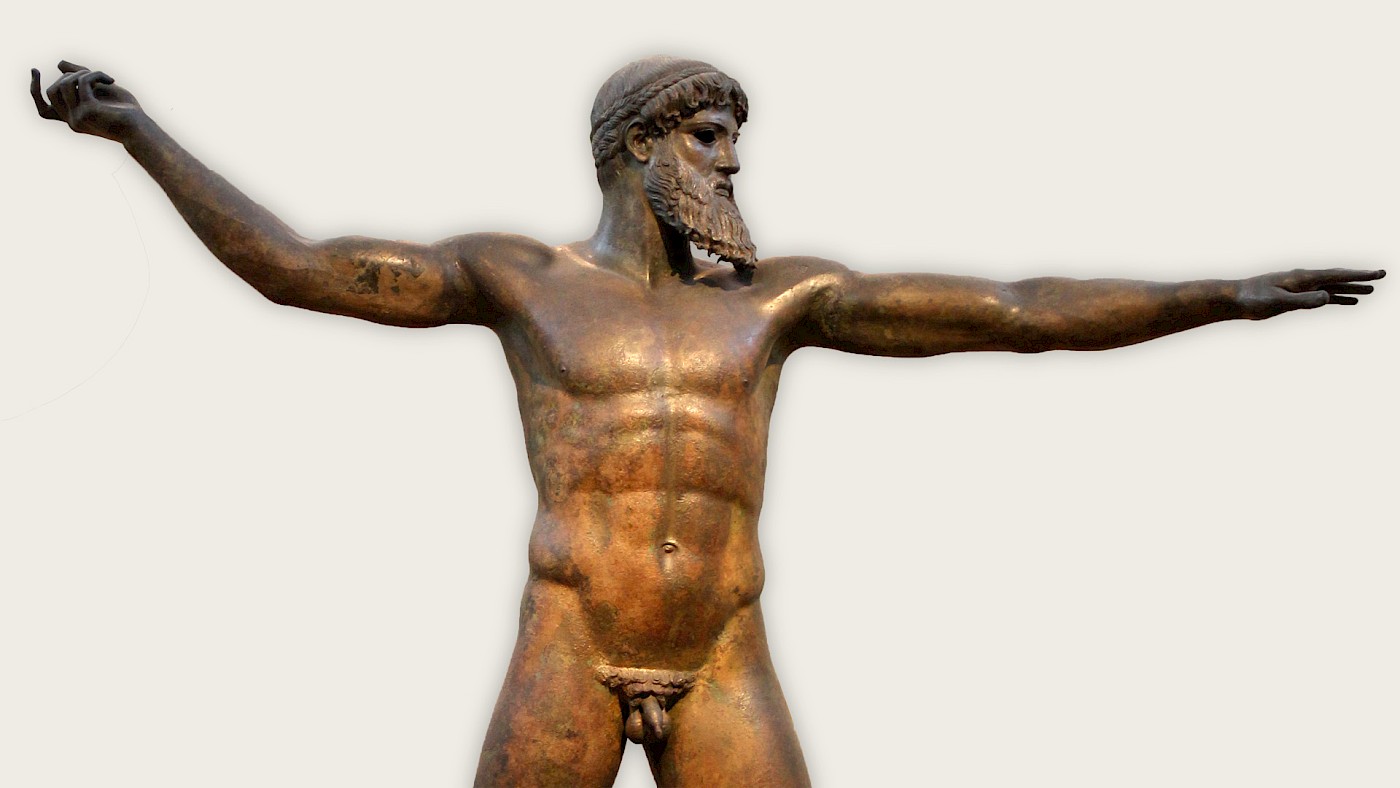The identity of a bronze statue discovered off the coast of Artemision, Euboea, has been under discussion for nearly a century. The statue, which stands 2.09m tall, was discovered in the remains of a shipwreck between 1926 and 1928; other finds indicate that the shipwreck must date after the middle of the second century BC, but the bronze statue dates stylistically to the mid-fifth century. Within a few years of its discovery, the so-called Artemision god was identified as either Zeus or Poseidon by different scholars for different reasons.
These days, scholars usually identify the statue as Zeus, with a few exceptions (Zeus: Boardman 1985, p. 53; Stewart 2008, p. 45; Baitinger 2014, p. 223; Stansbury-O’Donnell 2015, p. 11. Poseidon: Carpenter 1991, p. 40 mentions the statue alongside other depictions of Poseidon, although he does not make a definitive statement on which god it depicts). But in the popular mindset, the question is far from settled.
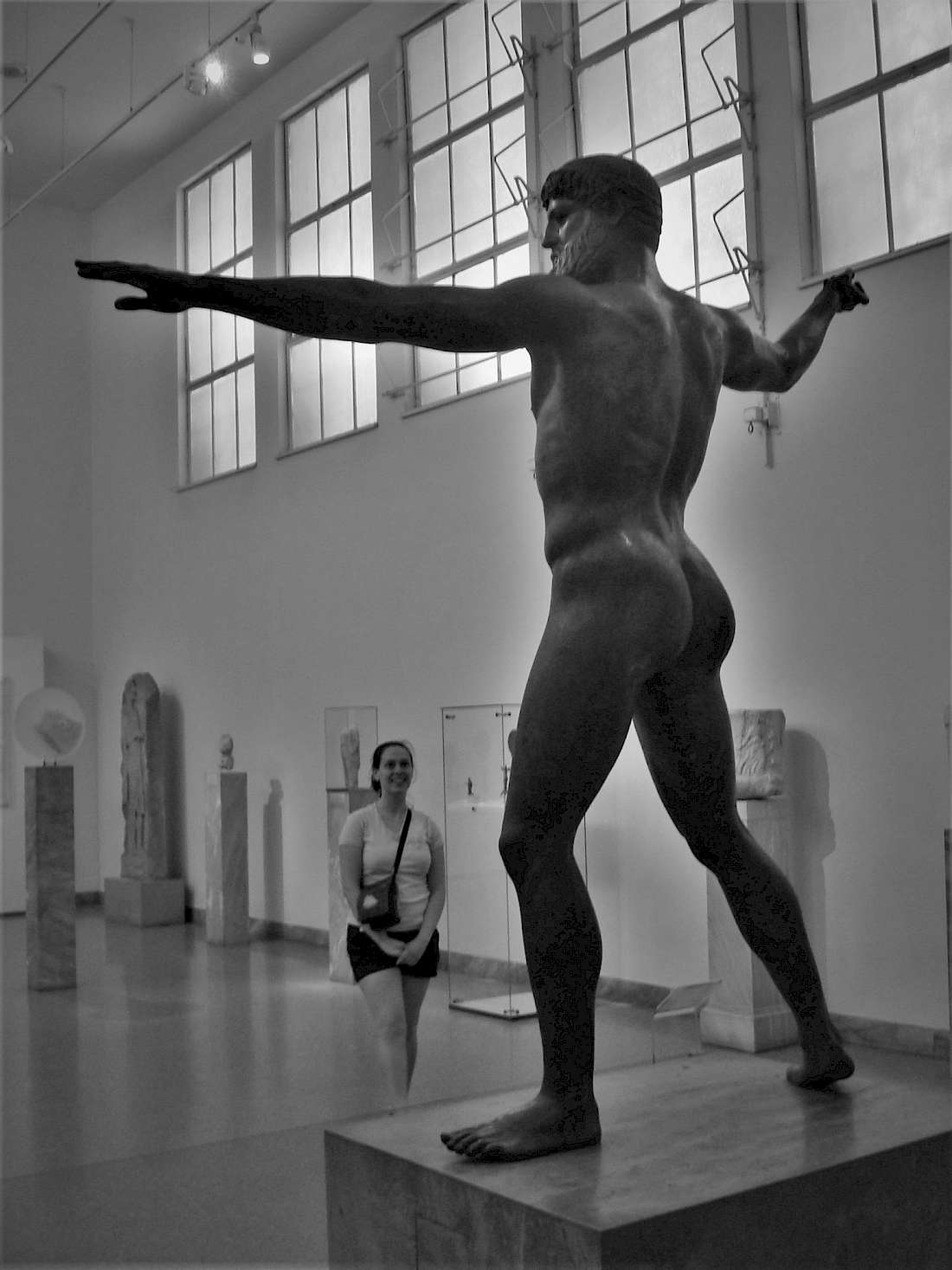
After seeing several Tweets about the statue emphasising this question of identification, I found myself wondering if this was really the most interesting thing that we had to say about one of the few surviving bronze statues from the fifth century BC.
First things first: it’s Zeus
One of the reasons why I personally find the question of the identity of the Artemision god uninteresting is because there are so many reasons to believe that the statue is Zeus, and so few arguments in favour of it being Poseidon. Most of the positive elements – features of the sculpture; contemporary parallels – point to Zeus; the main argument that it is Poseidon is that we cannot say with certainty that this is Zeus.
The right hand of the god, in which the missing attribute would have been held, seems more likely to have held a thunderbolt than a trident. The grip is loose, which, in combination with the outstretched left arm, suggests that the god was poised to throw what he held. This is an action taken by Zeus with his thunderbolt, not Poseidon, who strikes with his trident, requiring a firm grip (Mylonas 1944, p. 148).
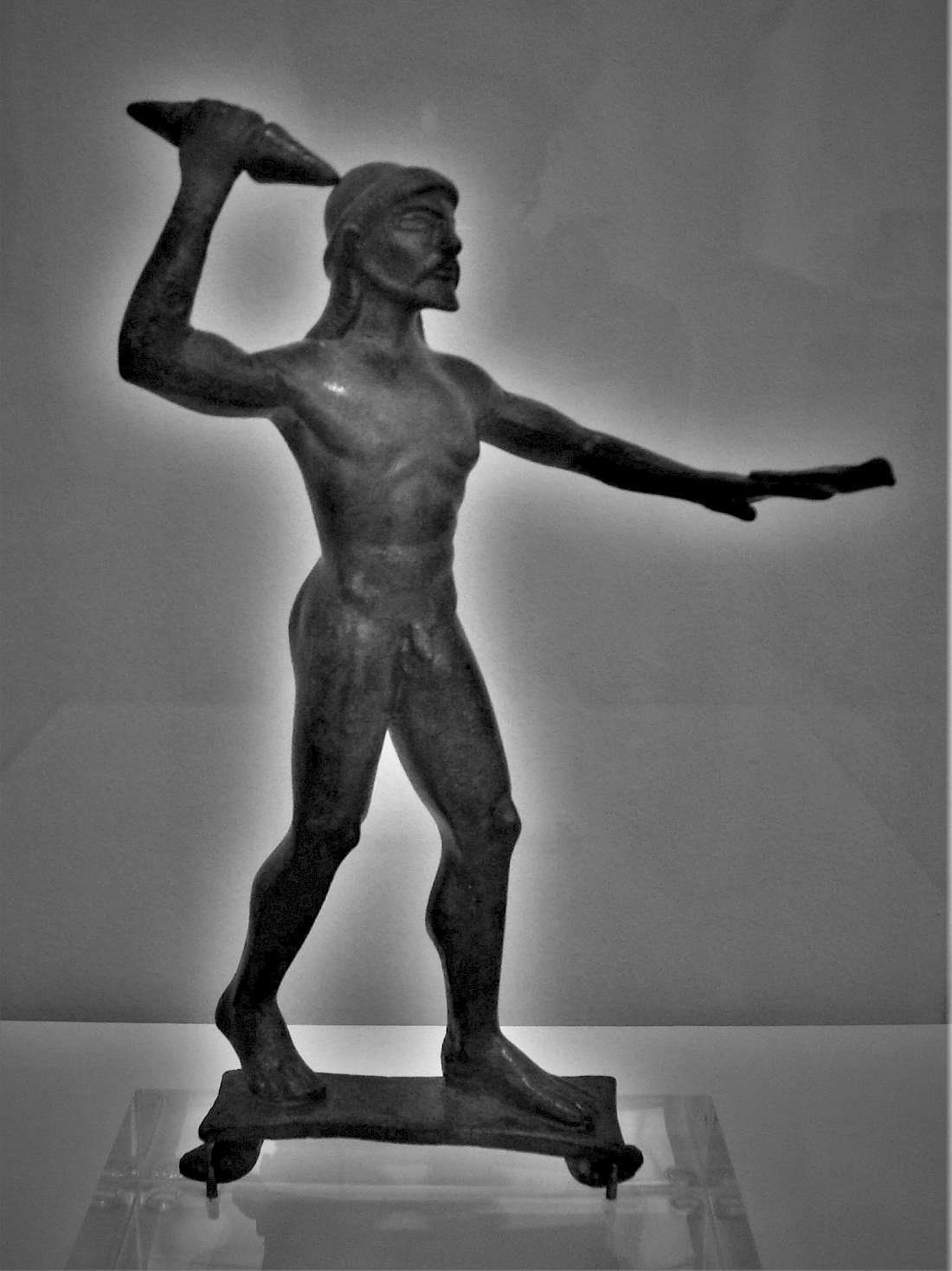
A thunderbolt, too, better fits the angle at which the attribute would have been directed. The best-case scenario for the trident has it sticking out, cutting across the view of the god’s head awkwardly (Mylonas 1944, p. 153); which, according to Boardman, “spoils the figure” (Boardman 1985, p. 53). But this is unlikely to have been the case, as in the loose grip of this statue the trident could not have been balanced with its head so far forward (Mylonas 1944, pp. 154-155); rather, it would have been held so far back as to obscure the god’s head or be awkwardly behind it (Stewart 2008, p. 45).
There are numerous parallels showing Zeus in this pose in architectural reliefs and smaller-scale bronze sculpture dating back to the seventh century, as well as contemporary vase painting. While some of these depictions include an eagle, absent here, this is no more trouble to identification as Zeus than the absence of a fish is to identification as Poseidon (Mylonas 1944, pp. 149-151).
Caroline Houser notes that some have argued that the god is Poseidon on the basis that the statue was found in the sea (Houser and Finn 1983, p. 79); but, as Houser notes, this fails to understand that the context was a shipwreck, not an intentional deposition of the statue.
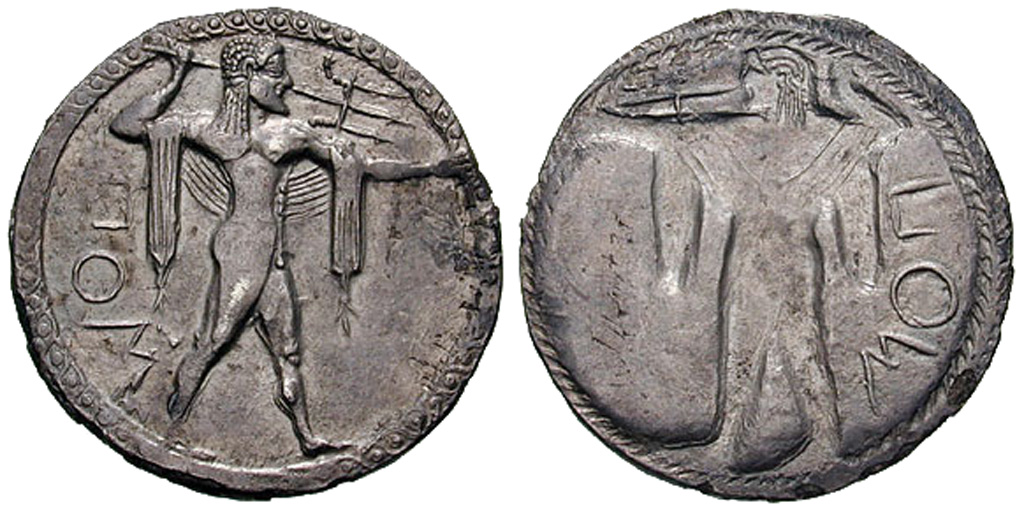
If there is a positive argument for identification of the figure as Poseidon, it rests entirely on the fifth-century coins of Poseidonia (Paestum) in Magna Graecia. The awkward positioning of the trident across the god’s face is also apparent on these coins; here the engravers make the shaft disappear behind Poseidon’s head in a way that would not have been possible in three dimensions. The Poseidonia coins also predate the traditional date of the Artemision statue, so they cannot have been directly inspired by it; rather, they may have been inspired by the Zeus-type, given that they extend the left arm in a throwing action – not typically an action Poseidon takes with his trident (Mylonas 1944, pp. 155-158). In any case, the coins highlight how awkward a position this is for Poseidon as much as they provide a potential parallel for the Artemision god.
The nearest known contemporary bronze statue of Poseidon, dated ca. 480 BC, depicts him in a quite different pose. Discovered in the bay of Livadostra in Boeotia, ancient Kreusis, the port of Platea, this Poseidon is now located in the adjacent room of the National Archaeological Museum in Athens to the Artemision god. Here the god strides forward, head straight, nothing in his pose to identify him. His attributes, which would have been held in his hands, are lost, but a dedicatory inscription, “ΤΟ ΠΟΤΕΙΔΑΟΝΟΣ ΗΙΑΡΟΣ” (Sacred to Poseidon), suggests who he is (Boardman 1985, p. 53).
Thus, the god may be Poseidon, based on the absence of attributes, but is most likely Zeus, based on the physical evidence and the great majority of parallels. But even if one is not convinced by this argument, there is much more than can be said about the Artemision Zeus.
Balance and poise
The vast majority of the surviving works of Greek sculpture are known in marble, but from the fifth century we know that bronze was an extremely important medium for free-standing sculptures. Many important bronze statues, such as the Tyrannicides or Myron’s Diskobolos, we know from Roman copies in marble; it seems that the original bronzes were recycled in antiquity.
Thus, those bronzes which survive, such as the Delphi Charioteer, the Riace warriors, and the Artemision Zeus, are especially important to our understanding of ancient sculpture. The majority of the survivals come from shipwrecks, although a few were excavated in context and provide anchoring points for our stylistic chronology beyond comparisons with other media and written accounts.
Of the surviving fifth-century bronzes, the Artemision Zeus is in the most dramatic posture. He is mid-action, pivoting to throw the thunderbolt, his hand loosening as his body begins to twist; he is poised on the ball of his right foot and the heel of his left.
Such a “pregnant moment” is typical of early Classical sculpture (Barringer 2014, pp. 222-223), recalling the stillness of the east pediment of the Temple of Zeus at Olympia, which depicts the moment before the chariot race of Oinomaos and Pelops in which the latter sabotages the former’s chariot. Yet it also recalls the action pose of the slightly earlier Tyrannicides, poised to strike at Hippias with their swords.
The comparison with the Tyrannicides is valuable because it emphasises the necessary differences in producing statuary in bronze and in marble. Such dynamic poses are much more difficult to manage in marble than in bronze as the tensile strength of marble is lower than that of bronze. Thus, in copies such as those of the Tyrannicides, the figures are supported by tree trunks, pillars, and struts added to the composition for this very purpose (Boardman 1985, pp. 16-17). How far it was necessary for Roman sculptors to adjust the pose of the statue is also unclear to us.
The Artemision Zeus needs no such supports, and thus his body is entirely on display. However, it also emphasises some of the limitations of the sculpture of this period. The Artemision Zeus “betrays no sign of effort or strain, and little sign even of formal movement.” (Stewart 2008, p. 46). Stewart argues that “this elevates him above mere human striving”, but this lack of effort is also a feature of copies of Myron’s mortal Diskobolos, as well as other fifth-century sculpture. It perhaps rather reveals to us that ancient sculptors’ interest in displaying the effects of movement on human musculature was less than their interest in conveying powerful stances.
The statue conveys power through its “careful balance of horizontals and verticals”; but also through the balanced posture – the engagement of the right arm and left leg and the relaxation of the right leg and left arm – an early, unusually dynamic example of the compositional device known as contrapposto (Stewart 2008, pp. 46-47). Many of our other examples of the new elements of classical sculpture are far less dynamic than the Artemision Zeus.
Close examination of the statue also reveals a number of physical details included by the artist to create optical effects. The larger-than-life size of the god, at 2.09 metres, is the most obvious divine attribute. The statue’s left arm is also a hand-length too long for its proportions, an element that may be significant when considering the original context (Stansbury-O’Donnell 2015, p. 239).
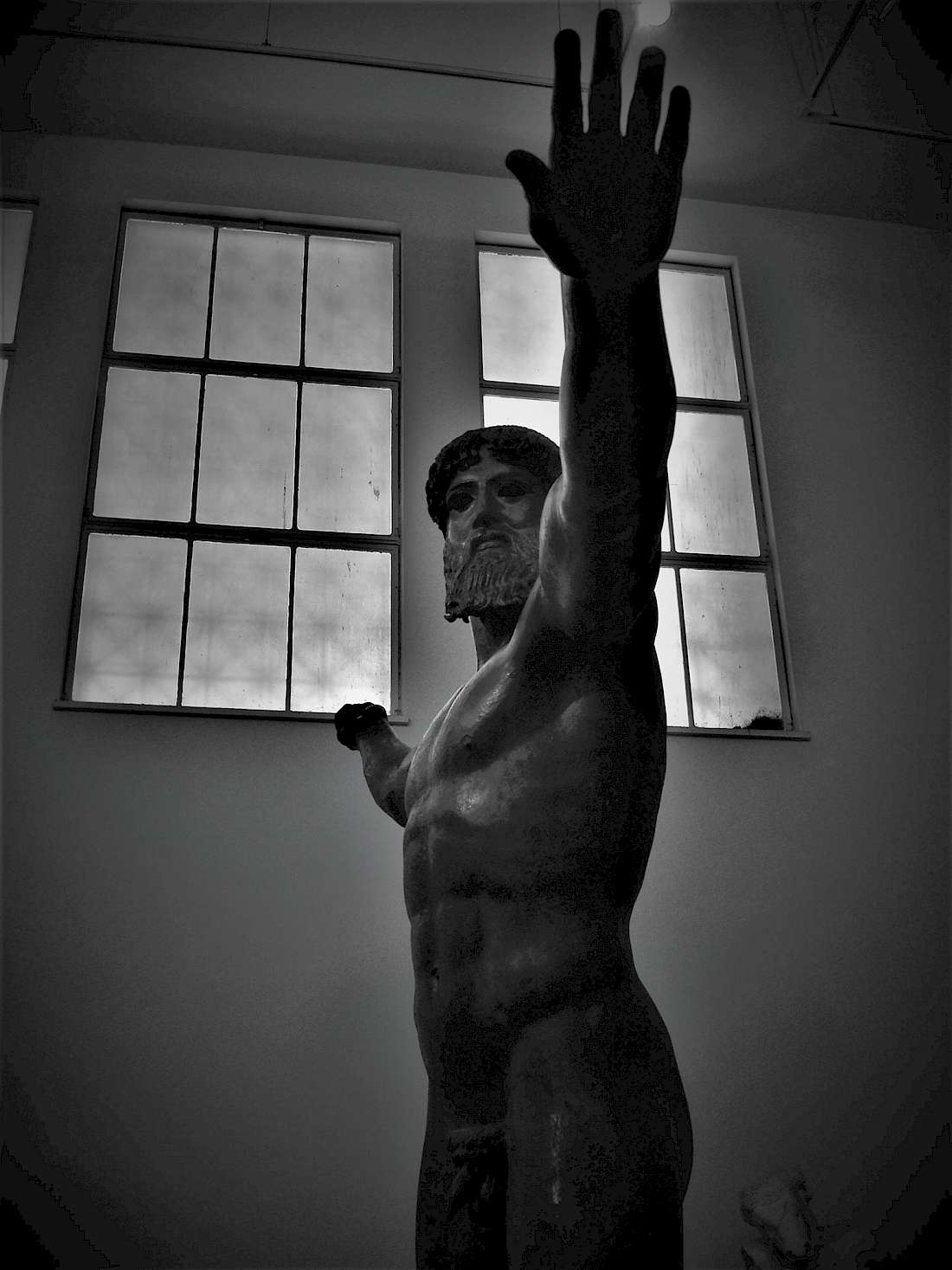
Many of these features rely on our acceptance of the fifth-century date of the Artemision Zeus. That is to say, if we are attempting to contrast this sculpture with its contemporaries, then we must accept the date assigned to this statue based on its style, which in turn feeds back into our understanding of the capabilities, interests, and thus style of the mid-fifth century. This problem to me seems more intractable than the question of the identity of the god, however the upshot seems to me to be much the same: at some point, we must accept what is probably the case in order to move forward in our discussion.
Imagining context
The archaeological context of the Artemision Zeus is known: it was found in a shipwreck off the north coast of Euboea, near Cape Artemision. But this is not its original display context, which is one of the reasons why its identity is somewhat obscured, but also limits our understanding of the function of this statue in the mid-fifth century BC.
One of the questions that arises with this statue is the question of point of view. Unlike Myron’s Diskobolos, the Artemision Zeus presents several dramatic views in three dimensions, and these provide hints as to its original context. Given that it is a depiction of a god, even if some question which one, it is likely that said context was a sanctuary. Following this assumption, Stansbury-O’Donnell suggests this statue would have been an important dedication and the viewer would approach it along a prescribed path (Stansbury-O’Donnell 2015, p. 11).
Indeed, the modern viewer approaches it along something of a prescribed route through the galleries of the National Archaeological Museum, where visitors encounter the statue in the chest-on view which “creates a striking composition for a photograph” (Stansbury-O’Donnell 2015, p. 11). The power of this perspective in two dimensions was recognized in antiquity, as this is the pose we see represented in the vase painting and on the coins that are parallels for this statue.
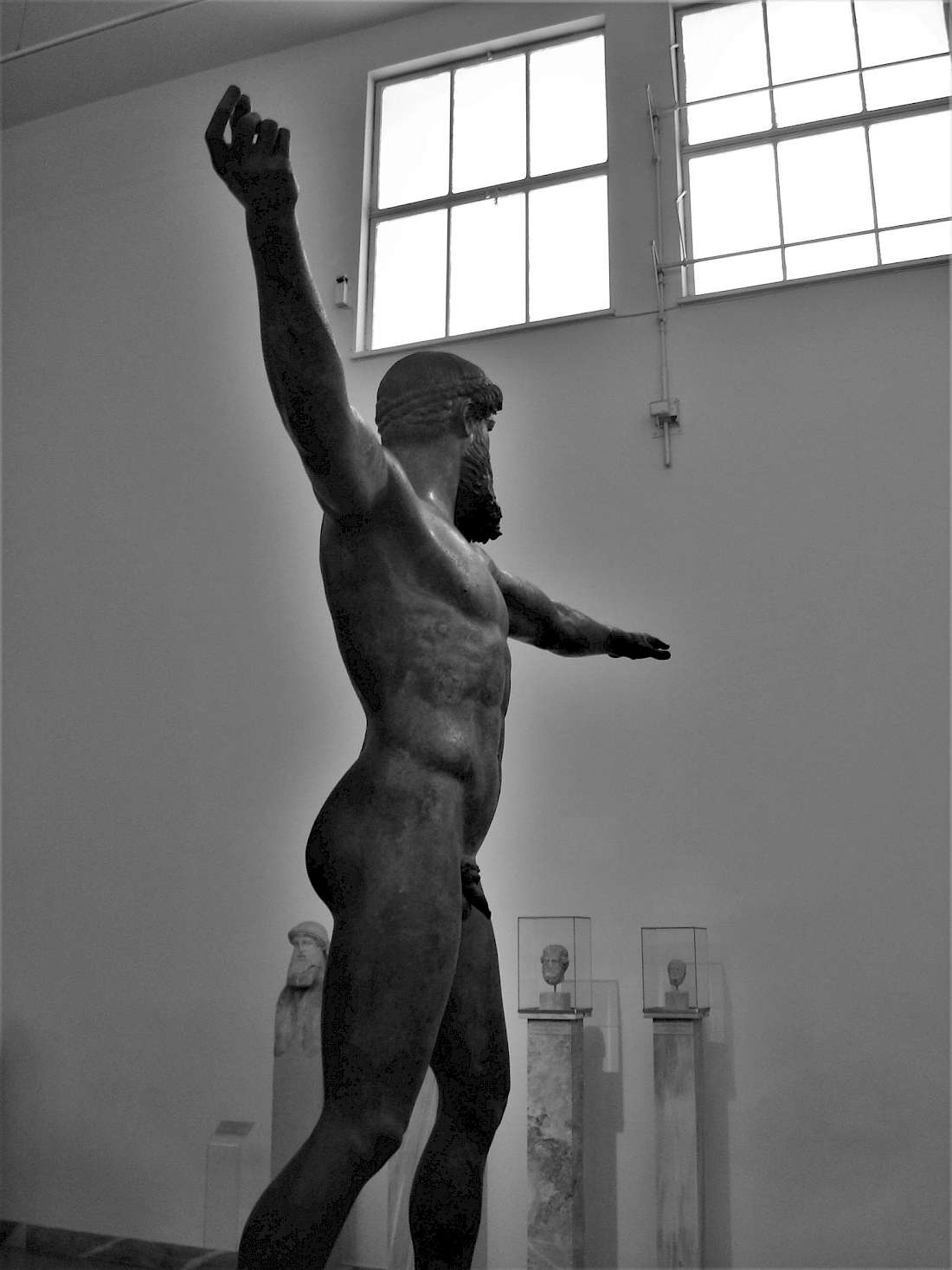
However, as Boardman noted, “the head-on aspect was no less important.” (Boardman 1985, p. 53). Stansbury-O’Donnell describes how the viewer approaching this statue from the front explains some of the physical features of the statue (Stansbury-O’Donnell 2015, pp. 11-12):
The weapon in the right arm would be aimed in the viewer’s direction, and the extended left hand would be sighting the target in the viewer’s direction too. From this vantage point, the lengthening of the arm adjusts for the foreshortened point of view and appears normally proportioned. This also changes the dynamics of viewing from the previous picture, in that the viewer is now also a target, a participant in the narrative action of the god. This view gives a dramatic vision of the power of a god and of the relationship between the human and divine missing in the other vantage point[.]
And what of other views? If the viewer stands behind the statue, they then become complicit in the actions of the god, watching him prepare to strike another mortal with his thunderbolt. From the back-side view, one could even imagine how this composition might work with a trident.
A rounded view
The Artemision Zeus allows us to think about the viewer of ancient Greek sculpture in several different ways. First, and most widely acknowledged, is the question of how an ancient viewer would identify the figure of a god based on context, attributes, and its place in the overall visual culture in which they lived.
Furthermore, the physical attributes of this particular statue indicate that the sculptor was thinking in the round. Unlike some contemporary sculpture, different perspectives of the Artemision Zeus give different impressions on the viewer. From the side, one is struck by the balance and poise of this early example of contrapposto; from the front, one is faced with the power the god has over mortals; from behind, perhaps, a similar effect, but with others as the potential victim of Zeus’s wrath.
If we focus too much on what is ultimately a minor detail about the statue – which god it represents – then we lose out on other fascinating aspects of ancient sculpture.
Further reading
- Judith M. Barringer, The Art and Archaeology of Ancient Greece (2014).
- John Boardman, Greek Sculpture. The Classical Period (1985).
- T.H. Carpenter, Art and Myth in Ancient Greece (1991).
- David Finn and Caroline Houser, Greek Monumental Bronze Sculpture (1983).
- George E. Mylonas, “The bronze statue from Artemision”, American Journal of Archaeology 48.2 (1944), pp. 143-160.
- Mark D. Stansbury-O’Donnell, A History of Greek Art (2015).
- Andrew Stewart, Classical Greece and the Birth of Western Art (2008).
